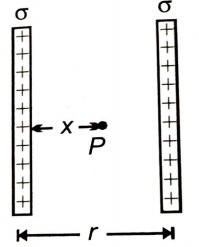For two infinitely long charged parallel sheets, the electric field at P will be:

1.
2.
3.
4. Zero

When a test charge is brought in from infinity along the perpendicular bisector of an electric dipole, the work done is:
1. Positive
2. Zero
3. Negative
4. None of these
Two small spheres each carrying a charge q are placed at distance r apart. If one of the spheres is taken around the other in a circular path, the work done will be equal to:
1. Force between them r
2.
3. Force between them
4. Zero
Work done in moving a charge q coulomb on the surface of a given charged conductor of potential V is:
1. joule
2. joule
3. joule
4. Zero
The variation of electric field between the two charges q1 and q2 along the line joining the charges is plotted against distance from q1 (taking rightwards direction of field as positive) as shown, then the correct statement is:
1. q1 and q2 are positive and q1 < q2
2. q1 and q2 are positive and q1 > q2
3. q1 is positive and q2 is negative
4. q1 is positive and q2 is negative and q1 < |q2|
Two identical infinite positive line charges are placed along the lines , in the x-y plane. A positive point charge placed at origin is restricted to move along y-axis. Its equilibrium is:
1. Stable
2. Neutral
3. Unstable
4. None of these
In the figure below, a point charge +Q1 is at the centre of an imaginary spherical Gaussian surface and another point charge +Q2 is outside of the Gaussian surface. Point P is on the surface of the sphere. Which one of the following statements is true ?
1. Both charges +Q1 and +Q2 contribute to the net electric flux through the sphere but only charge +Q1 contributes to the electric field at point P on the sphere.
2. Both charges +Q1 and +Q2 contribute to the net electric flux through the sphere but +Q2 contributes to the electric field at point P on the sphere.
3. Only the charge +Q1 contributes to the net electric flux through the sphere but both charges +Q1 and +Q2 contribute to the electric field at point P.
4. Only the charge +Q2 contributes to the net electric flux through the sphere but both charges +Q1 and +Q2 contribute to the electric field at point P.
In a Millikan-type experiment, there are two oil droplets P and Q between the charged horizontal plates, as shown in the diagram. Droplet P is in rest while droplet Q is moving upwards. The polarity of the charges on P and Q is
P Q
1. + +
2. Neutral -
3. - -
4. + -
In the electric field of a point charge q, a certain charge is carried from point A to B, C, D, and E, the work done:
1. is least along the path AB
2. is least along the path AD
3. is zero along any one of the paths AB, AC and AE
4. is least along AE.
A positively charged insulator is brougnt near(but does not touch) two metallic spheres that are in contact. The metallic spheres are then separated. The sphere which was initially farthest from the insulator will have:
1. no net charge
2. a negative charge
3. a positive charge
4. either a negative or a positive charge.











